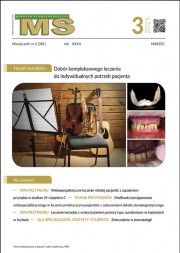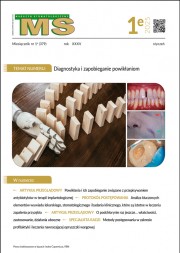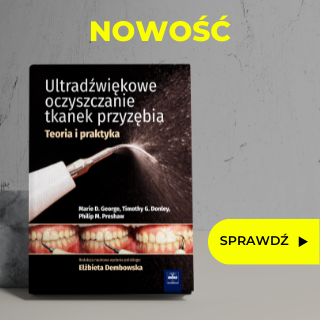Dostęp do tego artykułu jest płatny.
Zapraszamy do zakupu!
Po dokonaniu zakupu artykuł w postaci pliku PDF prześlemy bezpośrednio pod twój adres e-mail.
Możliwości postępowania wielospecjalistycznego w leczeniu protetycznym pacjentów z zaburzeniami układu stomatognatycznego – opisy przypadków
Agata Brykczyńska, Mirona Palczewska-Komsa, Bartosz Dalewski, Ewa Sobolewska
Piśmiennictwo
- Curtis DA, Lin GH, Rajendran Y i wsp. Treatment planning considerations in the older adult with periodontal disease. Periodontol 2000. 2021; 87(1): 157-165.
- Boyce RA, Klemons G. Treatment planning for restorative implantology. Dent Clin North Am. 2015; 59(2): 291-304.
- Okeson JP. Current terminology and diagnostic classification schemes. Oral Surg Oral Med Oral Pathol Oral Radiol Endod. 1997; 83(1): 61-64.
- Muts EJ, van Pelt H, Edelhoff D i wsp. Tooth wear: A systematic review of treatment options. J Prosthet Dent. 2014; 112(4): 752-759.
- Riley P, Glenny AM, Worthington HV i wsp. Oral splints for patients with temporomandibular disorders or bruxism: A systematic review and economic evaluation. Health Technol Assess. 2020; 24(7): 1-224.
- Green JI. Prevention and management of tooth wear: The role of dental technology. Prim Dent J. 2016; 5(3): 30-33.
- Mills IJ. A person-centred approach to holistic assessment. Prim Dent J. 2017; 6(3): 18-23.
- Wong J, Ong D, Khan A. Interdisciplinary management of an adult patient with significant tooth wear. Aust Dent J. 2023; 68(1): 58-69.
- Al-Moraissi EA, Farea R, Qasem KA i wsp. Effectiveness of occlusal splint therapy in the management of temporomandibular disorders: Network meta-analysis of randomized controlled trials. Int J Oral Maxillofac Surg. 2020; 49(8): 1042-1056.
- Hardy RS, Bonsor SJ. The efficacy of occlusal splints in the treatment of bruxism: A systematic review. J Dent. 2021; 108: 103621.
- Wieckiewicz M, Boening K, Wiland P i wsp. Reported concepts for the treatment modalities and pain management of temporomandibular disorders. J Headache Pain. 2015; 16: 106.
- Albagieh H, Alomran I, Binakresh A i wsp. Occlusal splints-types and effectiveness in temporomandibular disorder management. Saudi Dent J. 2023; 35(1): 70-79.
- Blasi A, Alnassar T, Chiche G. Injectable technique for direct provisional restoration. J Esthet Restor Dent. 2018; 30(2): 85-88.
- G-ænialTM universal injectable high strength restorative composite. On-line: https://www.gc.dental/europe/sites/europe.gc.dental/files/products/downloads/gaenialuniversalinjectable/leaflet/LFL_G-aenial_Universal_Injectable_en.pdf.
- Zhang H, Wang L, Hua L i wsp. Randomized controlled clinical trial of a highly filled flowable composite in non-carious cervical lesions: 3-year results. Clin Oral Investig. 2021; 25(10): 5955-5965.
- Zhu J, Wei J, Anniwaer A i wsp. Esthetic rehabilitation of labial tooth defects caused by caries of the anterior teeth using a composite resin injection technique with veneer-shaped 3D printing indices. J Prosthodont Res. 2025; 69(1): 127-132.
- Zhang Y, Zhang J, Fan L i wsp. Closing post-orthodontic spaces between anterior teeth using sequential 3D-printed direct composite injection guides. Oper Dent. 2022; 47(6): 612-619.
- EXACLEAR z GC. Transparentny materiał poliwinylosiloksanowy. On-line: https://www.gc.dental/europe/sites/europe.gc.dental/files/products/downloads/exaclear/leaflet/LFL_EXACLEAR_pl.pdf.















